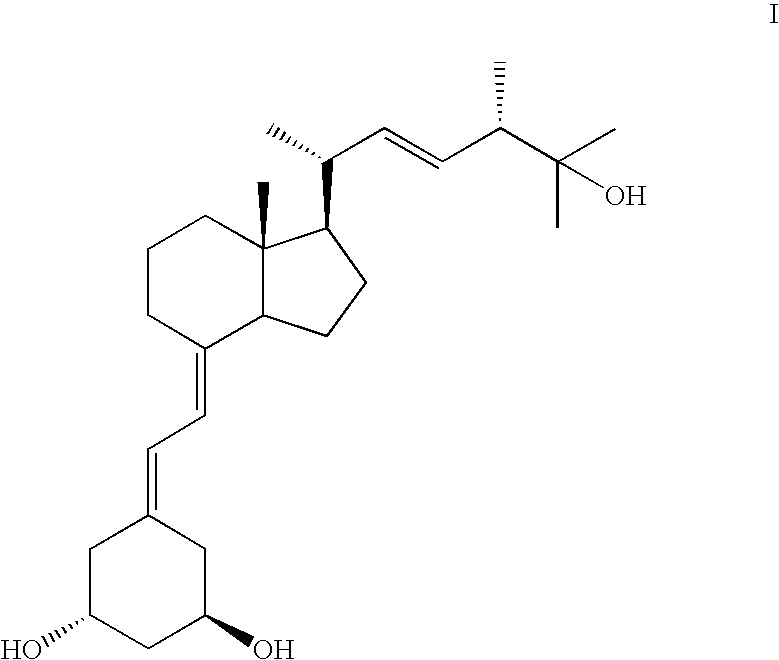Preparation of paricalcitol
a technology of paricalcitol and paricalcitol, which is applied in the field of paricalcitol preparation, can solve the problems of relative inactiveness in the body, limited ability to function as a vitamin, and inability to ensure the purity of the final product,
- Summary
- Abstract
- Description
- Claims
- Application Information
AI Technical Summary
Benefits of technology
Problems solved by technology
Method used
Image
Examples
example 1
Crystallization of Paricalcitol from Acetone
[0036] 500 mg of Paricalcitol were dissolved in 75 ml of acetone in a sonicator at 28° C. over a period of 15 minutes. The clear solution was filtered through glass wool into another flask, and the solution was then concentrated by evaporation, until the volume was 57.5 ml acetone (control by weight). The solution was cooled to −18° C., and the temperature was maintained at −18° C. for 20 hours. The crystals were filtered and washed with 20 ml of cold (−18° C.) acetone, then dried at high vacuum in an oven at 28° C. for 22 hours to obtain a yield of 390 mg (purity of 98.54%).
example 2
Crystallization of Paricalcitol from Acetone+Water
[0037] 540 mg of Paricalcitol were dissolved in 81 ml of acetone in a sonicator at 28° C. over a period of 15 minutes. The clear solution was filtered through glass wool into another flask, and 8 ml water was added. The solution was then concentrated by evaporation to a volume of 54 ml of acetone (control by weight). The solution was cooled to −18° C., and that temperature was maintained for 16 hours The crystals were filtered and washed with 20 ml of cold (−18° C.) acetone, and then dried at high vacuum in an oven at 28° C. for 6 hours to obtain a yield of 300 mg (purity of 99.79%).
example 3
Crystallization of Paricalcitol from Ethyl Acetate
[0038] 520 mg of Paricalcitol were dissolved in 100 ml of Ethyl acetate in a sonicator at 28° C. over a period of 15 minutes. The clear solution was filtered through glass wool into another flask, and the solution was then concentrated by evaporation to a volume of 86 ml of Ethyl acetate (control by weight). The solution was cooled to −18° C., and that temperature was maintained for 20 hours. The crystals were filtered and washed with 20 ml of cold (−18° C.) Ethyl acetate, then dried at high vacuum in an oven at 28° C. for 20 hours to obtain a yield of 360 mg (purity of 98.46%).
PUM
 Login to View More
Login to View More Abstract
Description
Claims
Application Information
 Login to View More
Login to View More - R&D
- Intellectual Property
- Life Sciences
- Materials
- Tech Scout
- Unparalleled Data Quality
- Higher Quality Content
- 60% Fewer Hallucinations
Browse by: Latest US Patents, China's latest patents, Technical Efficacy Thesaurus, Application Domain, Technology Topic, Popular Technical Reports.
© 2025 PatSnap. All rights reserved.Legal|Privacy policy|Modern Slavery Act Transparency Statement|Sitemap|About US| Contact US: help@patsnap.com

